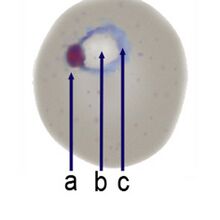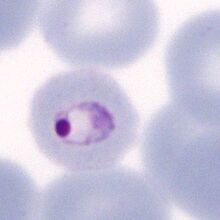Ring forms: Difference between revisions
From haematologyetc.co.uk
No edit summary |
No edit summary |
||
| (21 intermediate revisions by 2 users not shown) | |||
| Line 1: | Line 1: | ||
---- | |||
'''Navigation'''</br> | |||
[[Plasmodium falciparum: Morphology|Go Back]] | |||
---- | |||
--- | {| class="wikitable" style="border-style: solid; border-width: 4px; color:black" | ||
|colspan="1" style = "font-size:100%; color:black; background: FFFAFA"|<span style="color:navy>'''What is a ring form?'''</span> | |||
<gallery mode="nolines" widths="220px" heights="220px" > | <gallery mode="nolines" widths="220px" heights="220px" > | ||
| Line 18: | Line 22: | ||
At the earliest stage of red cell infection parasites of all species have the form of a "ring". Distinction between species at this stage may not be easy (or even possible). However as the | At the earliest stage of red cell infection parasites of all species have the form of a "ring". Distinction between species at this stage may not be easy (or even possible). However as the parasites mature and develop differences between species become more apparent. In some species the ring appearance is maintained until late stages of maturation, in others it is lost progressively as they mature. | ||
The different appearances of rings (or indeed their loss) can be very useful in identifying the different malaria species. For detailed illustration of maturing trophozoites [[Trophozoites: diagnostic guide|see this link]]: | |||
Latest revision as of 22:04, 18 March 2024
Navigation
Go Back
| What is a ring form?
The earliest stage following red cell invasion has a typical ting form:
Description
The different appearances of rings (or indeed their loss) can be very useful in identifying the different malaria species. For detailed illustration of maturing trophozoites see this link: |

